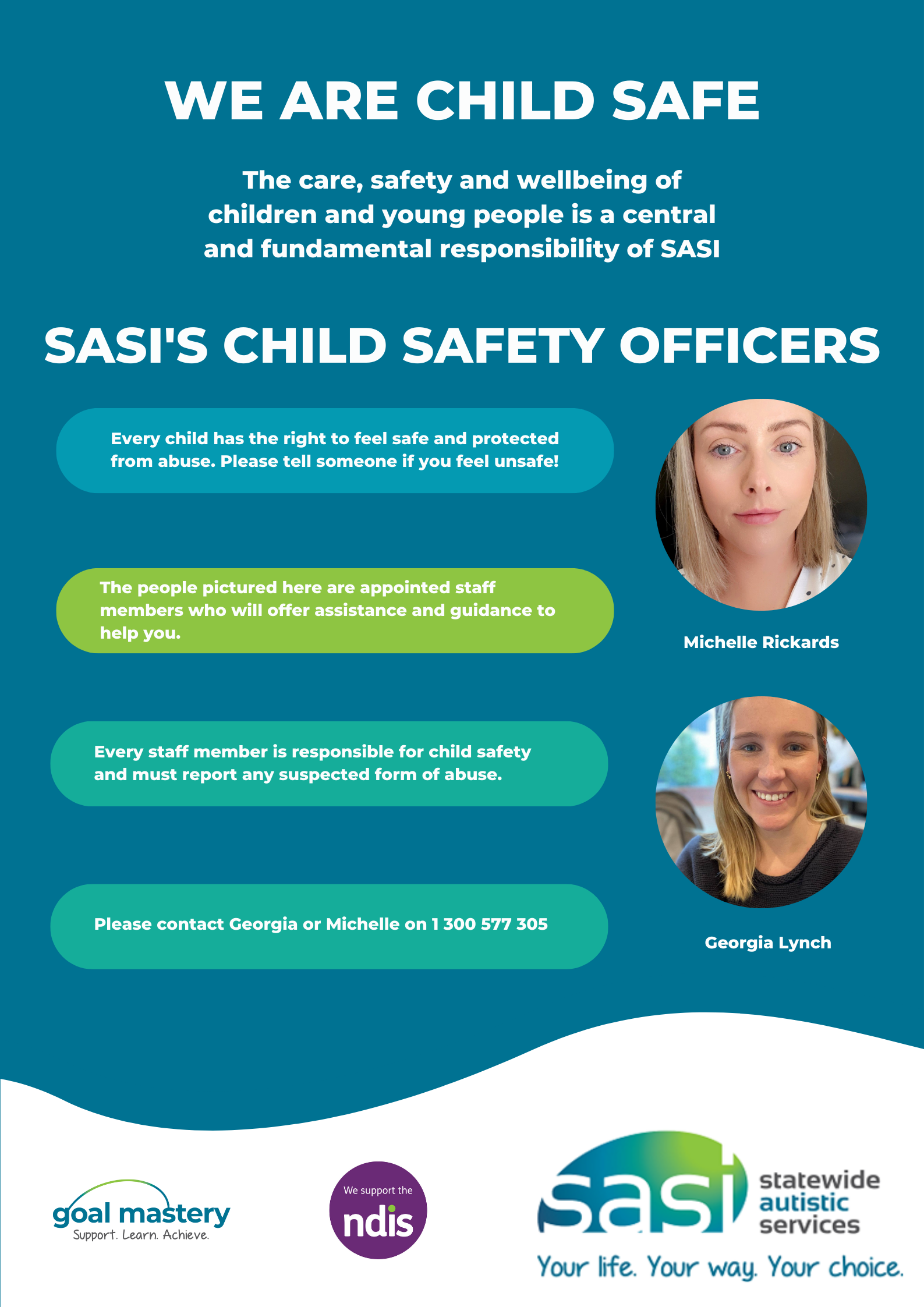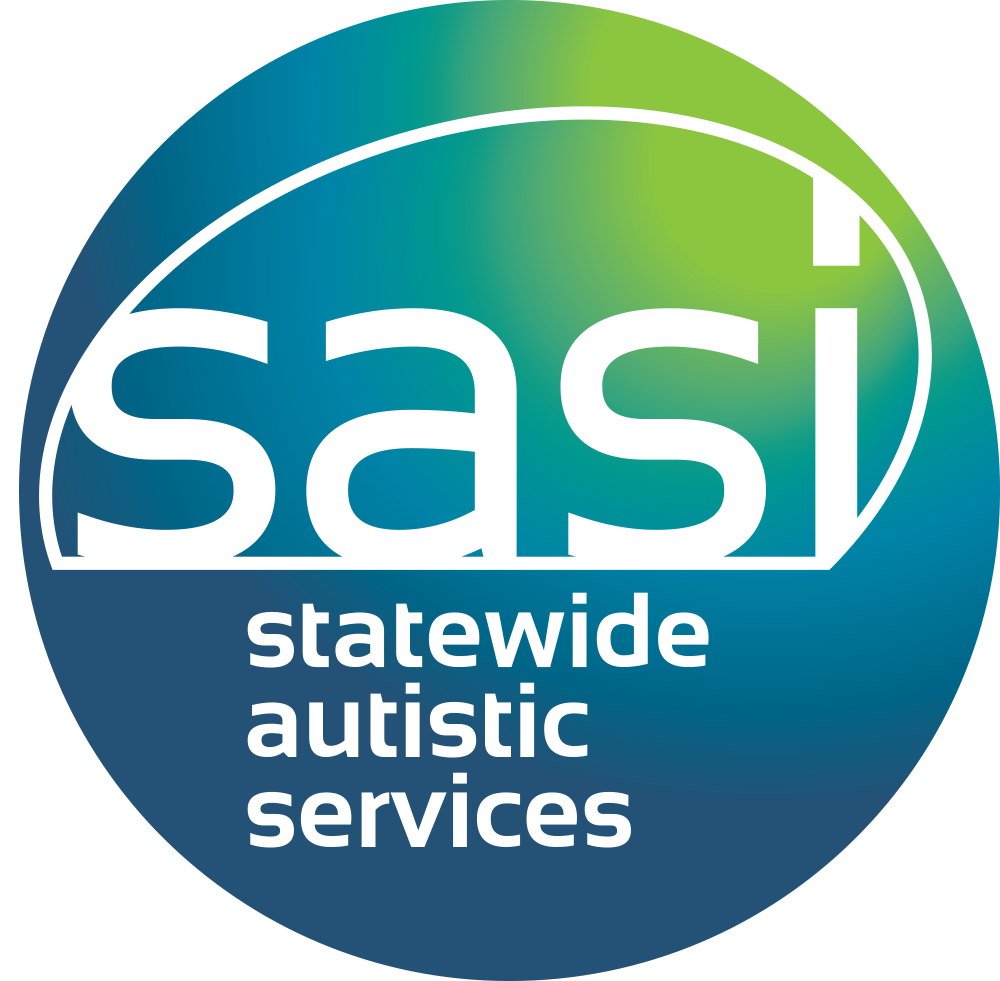Child Safe Standards

All organisations in Victoria that provide services or facilities to children must abide by the Child Safe Standards.
The standards were developed to promote the safety of children, prevent child abuse, encourage children to ‘have a say’ and ensure effective processes are in place if an allegation of abuse is made. Children with a disability are particularly vulnerable and SASI is committed to ensuring we have the processes and training in place to ensure children in our care are safe.
All organisations in Victoria that provide services or facilities to children must abide by the Child Safe Standards.
The standards were developed to promote the safety of children, prevent child abuse, encourage children to ‘have a say’ and ensure effective processes are in place if an allegation of abuse is made. Children with a disability are particularly vulnerable and SASI is committed to ensuring we have the processes and training in place to ensure children in our care are safe.
SASI is a child safe organisation
SASI is committed to being a Child Safe organisation and has zero tolerance for child abuse. We recognise our legal and moral responsibilities in keeping children and young people safe from harm and promoting their best interests.
We have developed and maintain targeted policies, procedures and training to support employees to achieve these commitments. We create environments where all children and young people have a voice and are listened to, their views are respected and they contribute to how we plan for, design and develop our services and activities. Recognising the definition of child for these purposes as including children and young people under the age of 18
All SASI employees have an obligation to report suspected cases of child abuse in accordance with our Policies, Procedures and Guidelines.
Background
Victorian organisations that provide services or facilities for children are required by law to implement Child Safe Standards to protect children from harm.
In 2012 and 2013 the Betrayal of Trust inquiry looked into the handling of child abuse by religious and non-government organisations. Its report highlighted poor and inconsistent practices for keeping children safe. It found some organisations’ cultures did not focus on children’s safety and many failed to report or act on child abuse allegations.
The focus of the Child Safe Standards is helping organisations drive cultural change so that protecting children from abuse is embedded in everyday thinking and practice. See Victoria Government Child Safe Standards for further information.
What is child abuse?
The Child Safe Standards aim to protect children from abuse in organisations. Under the Act, child abuse includes the following categories of abuse:
- Physical violence
- Sexual offences
- Serious emotional or psychological abuse
- Serious neglect
Our Approach
We want to protect all children that receive our services, programs and activities, and do what we can to keep children safe.
SASI has established a Child Safe Policy. The purpose of this policy is to:
- Outline our commitment to child safety
- Identify what we can do in our workplace, services, programs and activities to create an environment where children are safe and protected from abuse; and
- Communicate the process and expectation for reporting any allegations or reasonable suspicions of child abuse to the appropriate authorities.
While all children are vulnerable, SASI recognises that some children may be more vulnerable including:
- Children with disabilities
- Children from culturally and linguistically diverse backgrounds
- Aboriginal children
- Gay, lesbian, bisexual, transgender, intersex and queer (GLBTIQ) communities
SASI has adopted a model of support, whereby our Child Safe Champion roles have been expanded to incorporate Child Safe responsibilities, to provide guidance on our Child Safe processes as required.
This network is further supported by a designated Child Safe Officer, who have expertise and experience in the reporting protocols.
Understanding the Standards
The 11 Child Safe Standards are listed below. Organisations who are required to comply with the Standards need to implement all aspects of the 11 Standards.
Each of the Standards is expressed as a statement of an expected outcome that organisations must achieve. The new Standards also include minimum requirements, to provide more clarity for your organisation about what you need to do.
For each Standard, we have provided a list of documents and actions that will show that your organisation is meeting these minimum requirements. We call these compliance indicators.
The 11 Child Safe Standards
Standard 1
Organisations establish a culturally safe environment in which the diverse and unique identities and experiences of Aboriginal children and young people are respected and valued.
Standard 2
Child safety and wellbeing is embedded in organisational leadership, governance and culture.
Standard 3
Children and young people are empowered about their rights, participate in decisions affecting them and are taken seriously.
Standard 4
Families and communities are informed and involved in promoting child safety and wellbeing.
Standard 5
Equity is upheld and diverse needs respected in policy and practice.
Standard 6
People working with children and young people are suitable and supported to reflect child safety and wellbeing values in practice.
Standard 7
Processes for complaints and concerns are child-focused.
Standard 8
Staff and volunteers are equipped with the knowledge, skills and awareness to keep children and young people safe through ongoing education and training.
Standard 9
Physical and online environments promote safety and wellbeing while minimising the opportunity for children and young people to be harmed.
Standard 10
Implementation of the Child Safe Standards is regularly reviewed and improved.
Standard 11
Policies and procedures document how the organisation is safe for children and young people.
What should be reported?
Any child safety concerns, such as:
- Disclosure of abuse or harm
- Allegation of suspicion or observation
- Breach of Code of Conduct relating to child safety
- Environmental safety issues
Offences include:
- Failure to disclose: Reporting child sexual abuse is a community-wide responsibility. All adults in Victoria who have a reasonable belief that an adult has committed a sexual offence against a child under 16 have an obligation to report that information to the police.
- Failure to protect: People of authority are committing an offence if they know of a substantial risk of child sexual abuse, have the power or responsibility to reduce or remove the risk, but negligently fail to do so.
- Grooming: Grooming offence targets communication – including online communication – with a child under the age of 16 or their parents with the intent of committing child sexual abuse. This offence targets predatory conduct undertaken to prepare a child for sexual abuse at a later time with the groomer (aged 18 years old or over) or another adult.
- Mandatory reporting: Any personnel who are mandatory reporters (doctors, nurses, midwives, teachers – including early childhood teachers, principals and police) must report to child protection if they believe on reasonable grounds that a child is in need of protection from physical injury or sexual abuse.
For more information visit www.ccyp.vic.gov.au/

